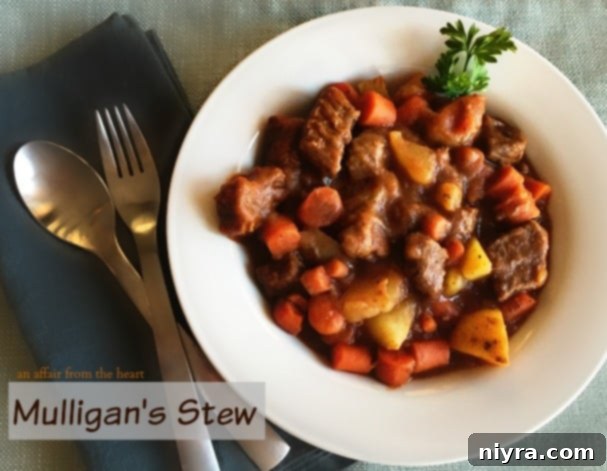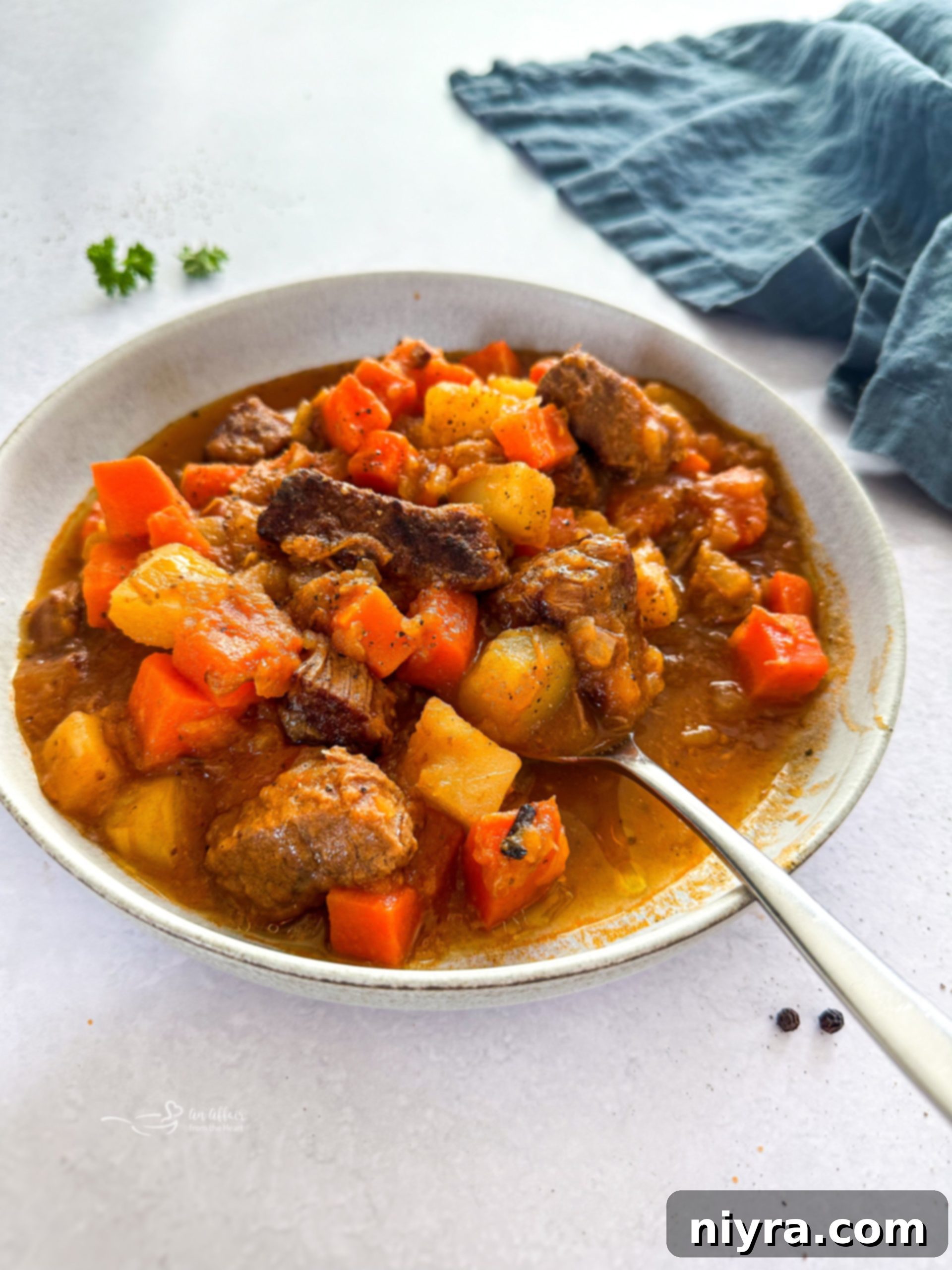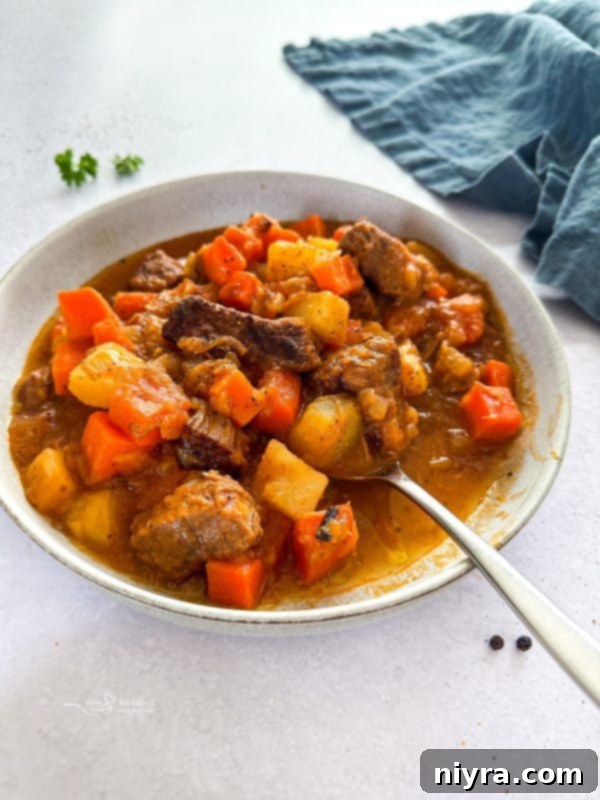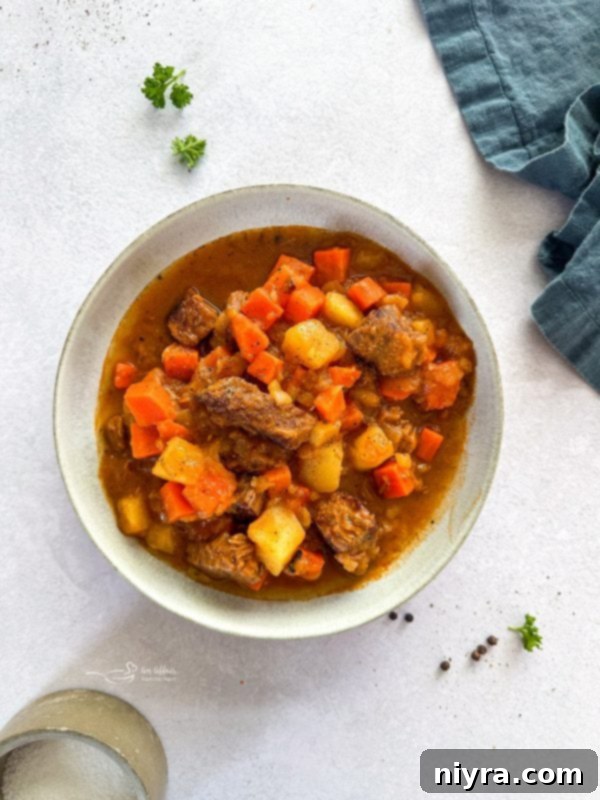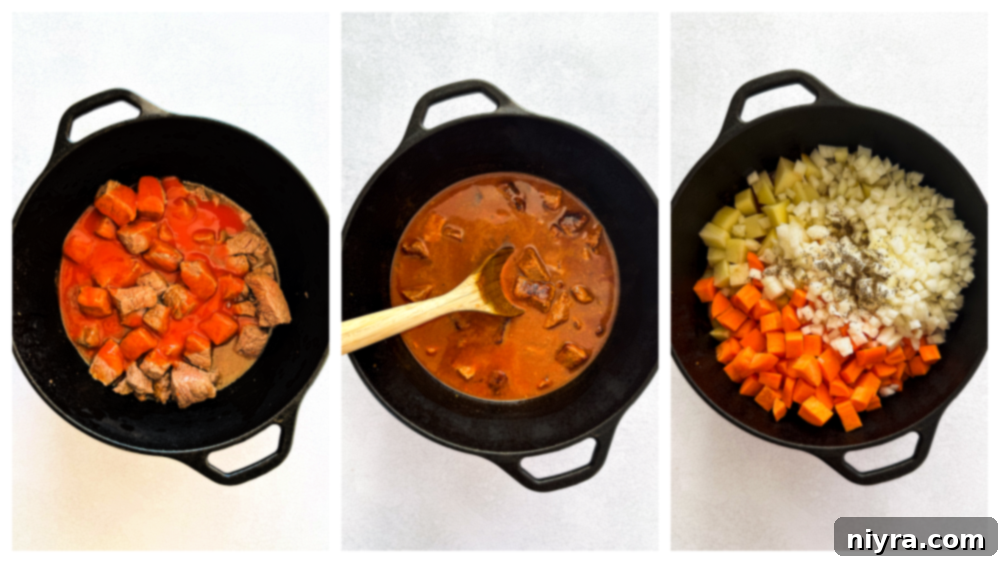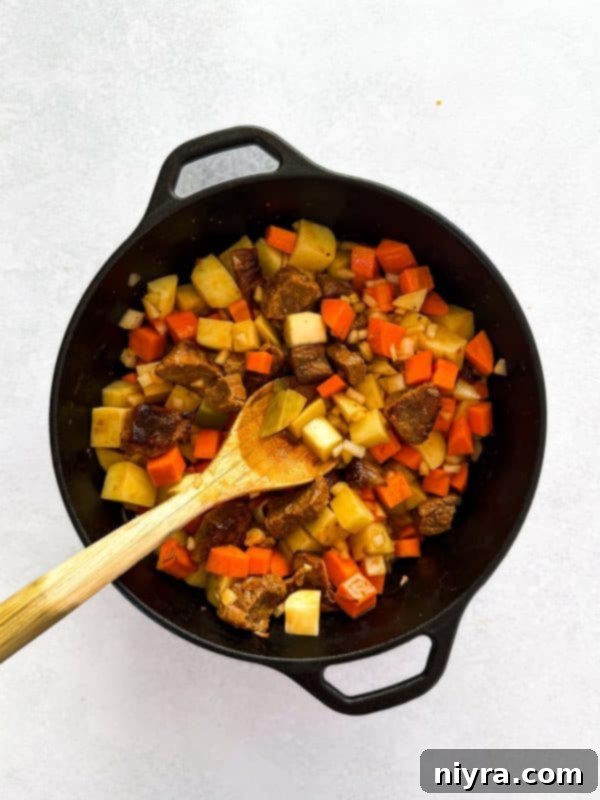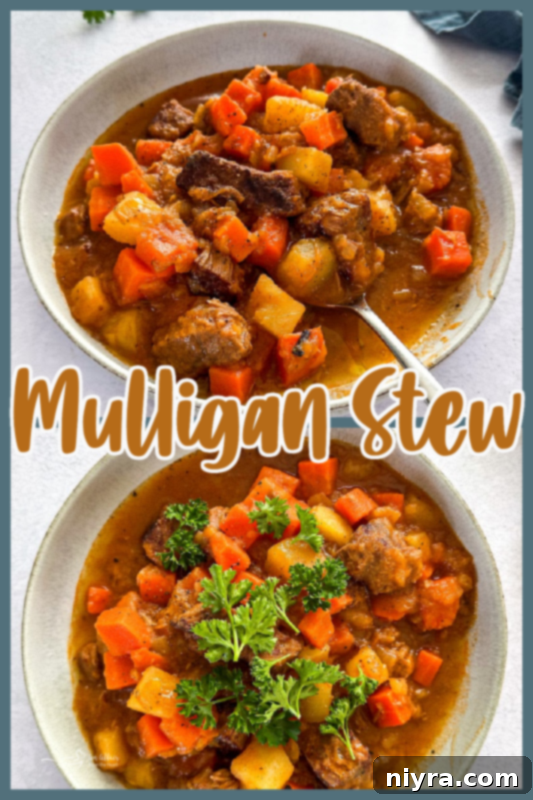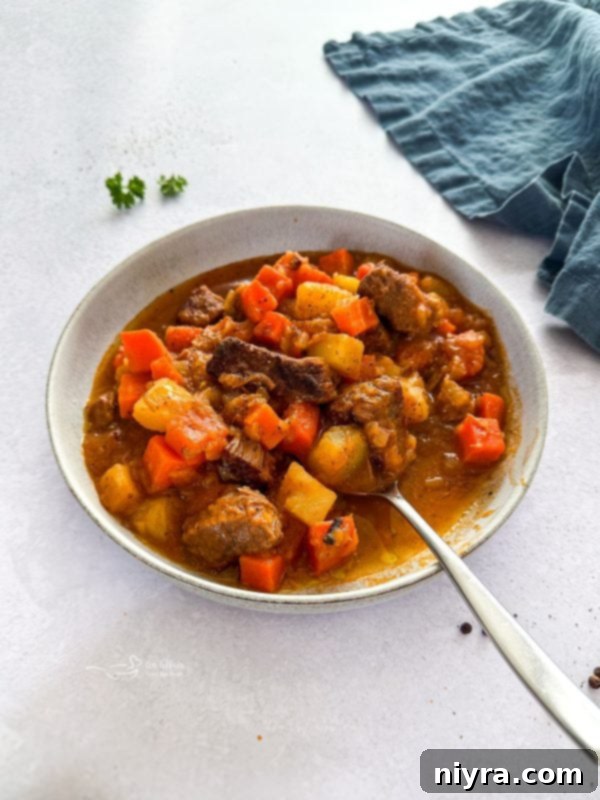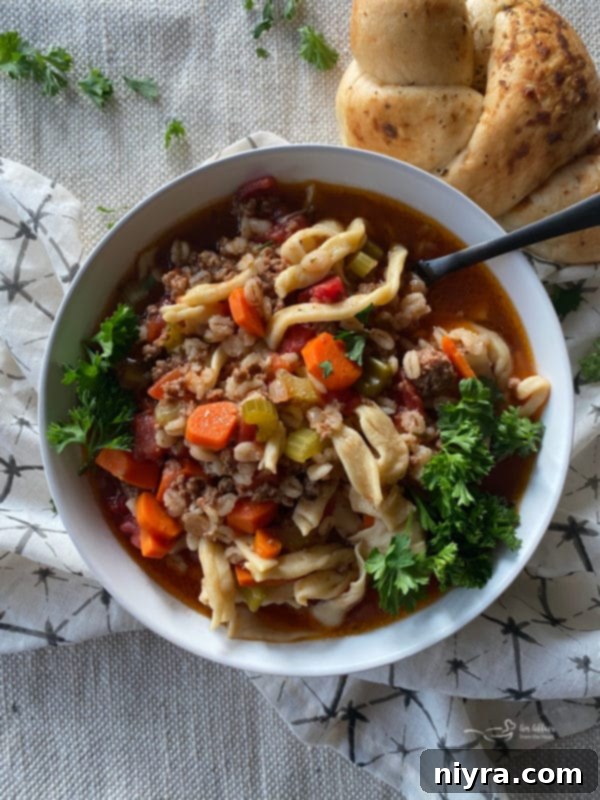Welcome to a culinary journey that celebrates comfort, simplicity, and a rich history – the beloved **Mulligan Stew**. This isn’t just a meal; it’s a heartwarming embrace in a bowl, a testament to the power of basic ingredients transformed into something extraordinary. Featuring succulent chunks of beef, tender carrots, and hearty potatoes, all simmered to perfection in a savory tomato-based broth, this stovetop recipe promises a satisfying family dinner that’s both easy to prepare and deeply nourishing. It’s a classic for a reason, cherished across generations, and perfectly adaptable to whatever fresh produce you have on hand.
My family’s connection to this stew runs deep. It’s so significant that my Mother-in-Law’s name graces this very recipe in our church cookbook – a true badge of honor in our community, signifying a dish so good it had to be shared. There’s a special trust in church cookbooks, isn’t there? You know if someone is putting their name on a recipe for the entire community to see, it’s bound to be a tried-and-true winner. No one wants to be judged for a terrible recipe, especially not in print!
If you’ve never ventured into the world of stew-making, this Mulligan Stew recipe is your perfect starting point. It’s incredibly straightforward, making it an ideal choice for beginner cooks, yet robust enough in flavor to satisfy seasoned chefs. Whether you prefer the slow, hands-off approach of a crock pot or the traditional method of simmering on your stovetop, this recipe delivers consistent, delicious results. We love serving this ultimate comfort food simply with a side of crusty bread and butter, perfect for soaking up every last drop of the rich, flavorful broth.
This dish holds a special place in my husband’s heart; it’s his go-to comfort meal, particularly cherished on cold, snowy days when the wind howls outside. But don’t let the imagery of winter fool you – its comforting embrace is welcome all year round. We enjoy this hearty beef stew regardless of the season, proving its universal appeal as a truly versatile family favorite.
The Enduring Appeal of Classic Mulligan Stew
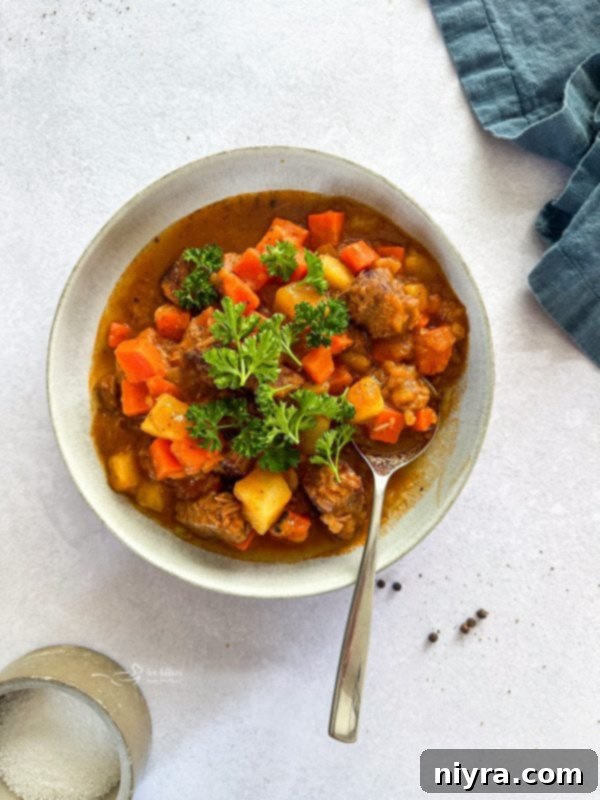
There’s an undeniable magic in classic ingredients like tender beef, sweet carrots, and earthy potatoes. These aren’t just components; they are the true staples of stew, working in harmony to impart deep flavor, satisfying texture, and vibrant color to a dish that is both hearty and immensely nourishing. When these essential elements are gently simmered with aromatic onions, a can of rich tomato soup, and a touch of browning sauce, the result is a savory, wholesome meal. It’s a dish so universally appealing, it’s bound to become a beloved favorite at any dinner table.
A Glimpse into the History of Mulligan Stew
The story of Mulligan Stew is as rich and robust as its flavor. Often referred to as “hobo stew,” its origins are commonly traced back to the early 1900s, a challenging era in American history, particularly during the Great Depression when food scarcity was a harsh reality for many. It’s said that this resourceful stew was a creation of American hobos, who would pool together whatever meager meat and vegetables they could “scrape together” or gather. The name “Mulligan” itself, a common Irish surname, adds to the intrigue, suggesting an adaptation of a classic Irish beef stew, made more accessible and versatile.
In those times, a ‘Mulligan’ came to signify a meal created from “odds and ends,” food scraps, or any bits and pieces one could find. This philosophy of resourcefulness is precisely what makes Mulligan Stew so timeless and adaptable. While our access to food is thankfully much easier today, the core principle of this stew remains incredibly relevant, especially as food prices continue to fluctuate. It encourages creativity and frugality in the kitchen, allowing you to use whatever ingredients you have on hand, transforming simple staples into a spectacular meal.
If the comforting flavors of this classic beef stew resonate with you, we’re confident you’ll also adore these other hearty recipes: Beef and Barley Stew, a satisfying one-pot meal; Ground Beef Ragout, perfect over pasta or polenta; or Beef and Noodles, another timeless classic for the whole family.
The Versatility of Mulligan Beef Stew
One of the most appealing aspects of Mulligan Beef Stew is its incredible versatility. It’s simple to prepare and offers endless possibilities for customization, allowing you to tailor it to your personal preferences or whatever ingredients are readily available. Whether you opt for fresh or frozen vegetables, or your preferred cut of meat, this stew adapts beautifully. It truly embodies the spirit of a ‘clean out the fridge’ kind of meal, where you can cleverly utilize any leftover ingredients lingering at the end of the week, minimizing waste and maximizing flavor.
Elevate your meal by serving this delightful stew with a freshly baked side. These fluffy Buttermilk Biscuits are perfect for scooping up the rich broth, or try a slice of sweet and savory Honey Cornbread. Together, they create a complete, immensely satisfying meal that feels both wholesome and indulgent.
Essential Ingredients for this Easy Mulligan Stew Recipe
Crafting this hearty Mulligan Stew begins with a selection of readily available and wholesome ingredients. The beauty of this recipe lies in its simplicity and the ability of each component to contribute significantly to the overall flavor and texture of the dish. For your convenience, a full printable recipe card with precise measurements and detailed instructions can be found at the bottom of this post.
- Beef Stew Meat: The star of the show. Choose your favorite cut of beef stew meat, such as chuck roast, cut into 1-inch cubes. Browning the beef properly is key to developing a deep, rich flavor foundation for your stew.
- Oil: A good quality cooking oil, like extra virgin olive oil, is perfect for browning the meat. Any neutral oil you have on hand will work just as well.
- Salt and Pepper: Essential seasonings that bring out the natural flavors of the ingredients. Adjust to your personal taste throughout the cooking process.
- Tomato Soup: A can of condensed tomato soup is a secret weapon in this recipe, acting as a foundational liquid that adds a unique tang and richness to the broth.
- Water: Used in conjunction with the tomato soup, typically two cans of water (using the empty tomato soup can for measurement) help create the perfect consistency for the stew’s liquid base.
- Carrots: Sliced carrots add a touch of sweetness, vibrant color, and a pleasant, tender texture after simmering.
- Potatoes: Cubed potatoes absorb the savory flavors of the broth and contribute a comforting, starchy element that thickens the stew naturally. Any type of potato will work, but waxy varieties tend to hold their shape better.
- Onion: Chopped onion, preferably a white or yellow variety, provides an aromatic base that deepens the overall flavor profile of the stew.
- Celery Seed: A small but mighty ingredient, celery seed imparts a subtle, earthy, and aromatic flavor that complements the other vegetables and beef beautifully.
- Kitchen Bouquet: This browning and seasoning sauce is entirely optional but highly recommended. It adds a deep, rich color and an extra layer of savory, umami flavor to the stew, making it even more appealing.
For an added layer of freshness and texture, I often like to include a couple of chopped stalks of fresh celery to my stew. My Mother-in-law, in her pragmatic wisdom, sometimes uses a bag of frozen mixed stew vegetables, which is a fantastic shortcut. And for a truly exceptional twist that makes this stew super yummy, if you can track down those delightful little frozen pearl onions, they add a sweet, delicate flavor that is simply divine, though I admit they aren’t always easy to find!
How to Master This Mulligan Stew Recipe
Creating this delicious one-pot beef stew is surprisingly simple and comes together quickly, making it a perfect meal for busy weeknights or a comforting weekend dinner. Follow these steps to achieve a rich, tender, and incredibly flavorful Mulligan Stew:
Step 1: Brown the Beef
Begin by heating your chosen oil in a sturdy Dutch oven or a large, heavy-bottomed pot over medium heat. Once the oil is shimmering, add the beef stew meat. Season generously with salt and pepper. Use a wooden spoon to gently stir and brown the meat evenly on all sides. This crucial step, known as searing, develops a deep, savory crust that locks in flavor and creates delicious “fond” (the browned bits at the bottom of the pot). As the meat browns, stir occasionally, making sure to scrape up any browned bits from the bottom of the pot – these are packed with flavor! If using, add the Kitchen Bouquet during this stage to enhance color and richness.
Step 2: Simmer the Beef
Once the beef is beautifully browned, reduce the heat to low. Pour in the can of tomato soup and then fill the empty soup can twice with water, adding both to the pot. Stir to combine all ingredients. Cover the Dutch oven tightly and let the stew gently simmer for about an hour, or until the beef becomes wonderfully tender. This slow simmering process allows the flavors to meld and the meat to break down into melt-in-your-mouth perfection.
Step 3: Add Vegetables and Finish
After the beef has tenderized, it’s time to add the fresh vegetables. Carefully stir in the sliced carrots, chopped onion, cubed potatoes, and the celery seeds. Re-cover the pot and continue to cook for an additional 30 minutes, or until the vegetables are fork-tender. Keep an eye on the liquid level; if the stew appears too thick or you desire more broth, add a little extra water. Conversely, if your stew is thinner than you prefer, simply cook it uncovered for a few minutes longer to allow some of the liquid to evaporate and the stew to naturally thicken to your desired consistency.
Storing and Reheating Leftovers:
Any leftover Mulligan Stew can be stored in an airtight container in the refrigerator for up to 3 days, making it excellent for meal prep. For longer storage, this stew freezes beautifully for up to 3 months. To enjoy later, simply defrost the frozen stew in the refrigerator overnight, then reheat gently on the stovetop over low heat, stirring occasionally, or warm individual portions in the microwave until heated through. The flavors often deepen and become even more wonderful the next day!
Love it? Pin it!
If you’re already envisioning this delightful hobo stew gracing your dinner table, make sure you don’t lose this amazing recipe! Pin it to your favorite Pinterest recipe board before you go, so it’s always just a click away when hunger strikes!
Frequently Asked Questions (FAQs) about this Classic Stew
What exactly is Mulligan stew made of? Mulligan stew is typically a hearty concoction made with whatever meat (most often beef) and vegetables are available. Common ingredients include potatoes, carrots, onions, and a savory broth, but its defining characteristic is its flexibility – you can literally throw in whatever else you have on hand.
Why is it called Mulligan stew? The “Mulligan” in Mulligan stew is widely believed to be derived from a popular Irish surname. The stew itself is considered an adaptation of a classic Irish Beef Stew, evolved into a more versatile and often improvisational dish. During the challenging times of the Great Depression, this type of stew gained popularity as it could be made with whatever food scraps or inexpensive ingredients people could find, embodying a spirit of resourcefulness.
What is another common name for Mulligan stew? Another well-known name for Mulligan stew, reflecting its resourceful origins, is “hobo stew.”
What distinguishes a hobo stew? A hobo stew, by its very nature, is a flexible and adaptable meal. It’s traditionally made with whatever meat or vegetables one can scrounge up or has readily available, making it a budget-friendly and creative dish.
What does ‘a Mulligan’ signify in a culinary context? In the context of this recipe, ‘a Mulligan’ refers to a stew created from a medley of “odds and ends,” leftover food scraps, or simply whatever bits and pieces of ingredients you happen to discover in your pantry or fridge.
What Are Great Side Dishes to Serve with Beef Stew?
A comforting bowl of beef stew pairs wonderfully with a variety of simple yet satisfying sides that are perfect for dipping and soaking up the rich broth. Here are some excellent choices:
- Peasant Bread: A rustic, chewy bread with a delightful crust, ideal for sopping up every drop.
- Crusty Dutch Oven Bread: Another fantastic option, boasting a wonderfully crisp crust and a soft interior.
- Crock Pot Applesauce: A sweet and tangy contrast that cleanses the palate beautifully after a rich stew.
- Cheesy Cornbread Drop Biscuits: Fluffy, cheesy, and incredibly flavorful, these biscuits are a delightful accompaniment.
Creative Substitutions for Your Mulligan Stew
The beauty of Mulligan Stew lies in its adaptability. Remember, when it comes to making substitutions, don’t hesitate to get creative and tailor the recipe to suit your personal taste, dietary preferences, or whatever ingredients you have on hand. Make it truly your own!
Meat Alternatives: Instead of beef chunks, try using ground beef for a quicker cook time and a different texture. Pork shoulder or even chicken thighs, cut into cubes, could also work well for a different flavor profile.
More Veggie Goodness: Expand the vegetable medley! Consider adding green beans, corn kernels, peas, bell peppers, parsnips, or even mushrooms for extra flavor and nutrients. Frozen vegetable mixes are a convenient option.
Broth Base Variations: While tomato soup provides a unique flavor, you can substitute a combination of tomato paste diluted with an equal amount of cold water, or use beef broth, vegetable broth, or even a can of crushed tomatoes for a richer tomato flavor. Adjust seasoning accordingly.
Herb and Spice Boost: Experiment with fresh or dried herbs like thyme, rosemary, or bay leaves for added aromatics. A dash of smoked paprika or a pinch of red pepper flakes can introduce warmth and a subtle kick.
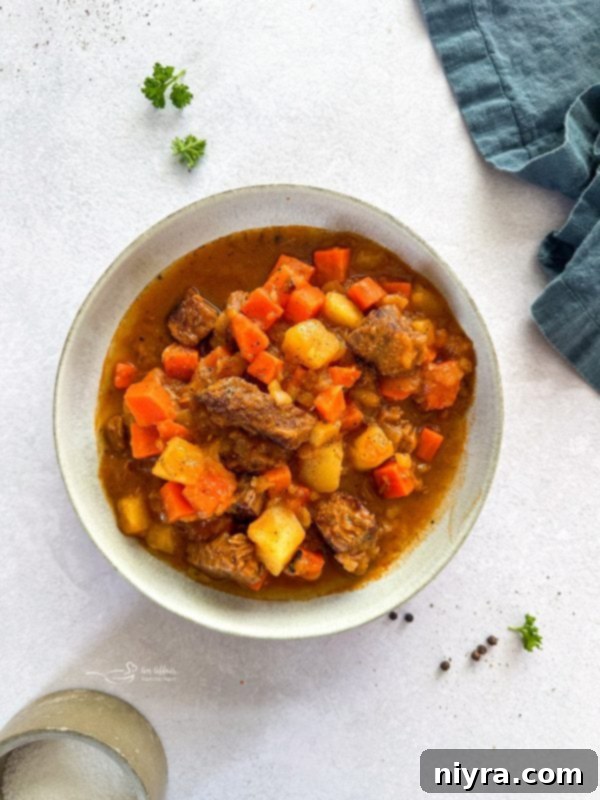
Expert Tips & Tricks for the Perfect Mulligan Stew
Achieving a truly exceptional Mulligan Stew is easy with a few insider tips and tricks. These suggestions will help you elevate your stew, ensuring it’s perfectly cooked, flavorful, and exactly to your liking:
Choose the Right Potatoes: For the best texture, opt for waxy potatoes such as red potatoes, Yukon Golds, or new potatoes. These varieties hold their shape beautifully during the long simmering process, preventing them from dissolving into the stew. While russet potatoes can be used, their higher starch content might make them break down more, potentially making the stew too starchy.
Slow Cooker Adaptation: Transform this stovetop recipe into a convenient slow cooker meal. First, brown the beef on the stovetop as directed to develop essential flavor. Then, transfer the browned beef and all other ingredients into your slow cooker. Cook on low for 6-7 hours or on high for 3-4 hours, until the meat is incredibly tender and the vegetables are cooked through.
Amplify Flavor with Aromatics: For an even deeper and more complex flavor profile, stir in a few bay leaves during the simmering process, adding warmth and aroma. Minced garlic cloves, sautéed briefly with the onions, will infuse the stew with a pungent depth. A dash of Worcestershire sauce also adds a lovely umami note and savory complexity.
Adjusting Consistency for Stew or Soup: If you prefer a thinner, more soup-like consistency, simply add extra beef broth or chicken broth until it reaches your desired liquid level. For a heartier, thicker stew, you have a couple of options: either cook the stew uncovered for the last 15-20 minutes to allow excess liquid to evaporate, or stir in a thickening agent. A slurry made from 1-2 tablespoons of all-purpose flour or cornstarch mixed with an equal amount of cold water can be whisked into the simmering stew until it thickens.
Add More Hearty Elements: To make your stew even more substantial, consider adding lima beans or any other canned beans you might have in your pantry, such as kidney beans or cannellini beans. Just drain and rinse them before adding during the last 30 minutes of cooking.
Searing is Key: Don’t skip browning the beef! This step creates a rich, caramelized crust that adds tremendous depth of flavor to the entire stew. It’s the foundation for a truly delicious result.
Taste and Adjust: Always taste your stew before serving. Adjust salt, pepper, and any other seasonings as needed. Sometimes a little extra pinch of salt can make all the difference in bringing out the flavors.
More Comforting Recipes to Love
If you’re a fan of the warming and hearty qualities of stew, you’ll surely enjoy exploring these other delicious and comforting recipes from our collection:
Oyster Stew: A unique and surprisingly delicate seafood stew, perfect for special occasions.
Rustic Harvest Stew: A vibrant and vegetable-rich stew that celebrates the bounty of the season.
Taco Stew: A flavorful and zesty twist on classic stew, packed with Tex-Mex spices.
Stuffed Pepper Soup: All the beloved flavors of stuffed peppers, transformed into a comforting soup.
Hamburger Soup With Or Without Noodles (pictured above): A family-friendly classic, versatile and wonderfully satisfying.
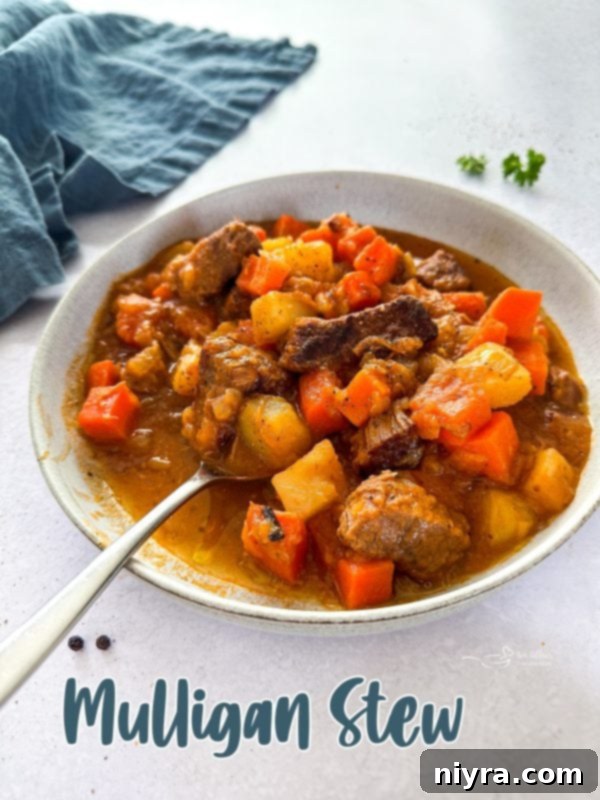
This Mulligan Beef Stew is truly the perfect comfort food, a dish that transcends generations and brings warmth to any gathering. I sincerely hope that your family enjoys this timeless recipe for years to come, just as mine has cherished it for so long. Happy cooking!

LIKE THIS RECIPE?
Don’t forget to give it a star rating and
leave a comment below the recipe!

Mulligan Stew
Simple ingredients and easy to follow recipe for beef stew.
Ingredients
- 1 1/2 pounds beef stew meat
- 1-2 Tablespoons oil
- 1 teaspoon salt
- 1/2 teaspoon seasoned pepper
- 1 can tomato soup
- 2 cans water (using the soup can)
- 3 carrots, sliced
- 3 potatoes, cubed
- 1 large onion, chopped
- 1/2 teaspoon celery seed
- 1/2 Tablespoon Kitchen Bouquet (optional)
Instructions
- Heat oil in a dutch oven over medium heat. Add stew meat, season with salt and pepper. Brown evenly. Add Kitchen Bouquet.
- Reduce heat. Add tomato soup and water, cover and let simmer for about an hour, or until meat is tender.
- Add carrots, onion, potatoes and celery seed. Cover and cook for 30 minutes more. If there is not enough liquid add a little water. If stew is too thin, cook uncovered to thicken.
Notes
To prepare stew in a crock pot, brown meat before adding to the crock pot. Add everything to pot and cook on low for 6-7 hours.
I like to add a couple of chopped stalks of celery to mine also. My Mother-in-law uses frozen stew veggies in hers sometimes, too. The other thing that makes this super yummy? If you can find those little frozen pearl onions, but I can’t always find them.
Nutrition
Serving: 1 | Calories: 289kcal | Carbohydrates: 21g | Protein: 30g | Fat: 10g | Saturated Fat: 3g | Polyunsaturated Fat: 7g | Cholesterol: 84mg | Sodium: 455mg | Fiber: 3g | Sugar: 5g
This recipe was originally posted on December 9, 2015. It has been updated to improve user experience and reshared on March 13, 2024.
